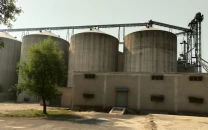Circular debt reaches Rs5.73tr
Despite price hikes, power and gas sectors cross Rs2.7tr, Rs3tr respectively

Despite constant increases in electricity and gas prices, Pakistan’s energy sector circular debt has spiralled alarmingly to a record Rs5.73 trillion—an amount Rs1.5 trillion more than what the International Monetary Fund had been informed of two months ago.
Official documents reveal that as of the end of November, the power sector had crossed over Rs2.7 trillion. Additionally, the gas sector circular debt also surged over Rs3 trillion, bringing the total unfinanced debt to Rs5.73 trillion.
The total energy sector circular debt now equals 5.4% of the size of Pakistan’s economy, as the wrong policies of ending the circular debt through price increases have failed to yield the desired results.
The figure is nearly Rs1.5 trillion or 1.4% of the GDP higher than what the IMF had been informed of just two months ago.
“With the combined circular debt across power and gas sectors exceeding 4% of the GDP, immediate action was critical,” according to the IMF statement issued on November 15th after reaching a staff-level agreement with Pakistan for the completion of the first review of the $3 billion bailout package.
The figures also depict a failure on the part of the World Bank, the IMF, and the government—the trio that has long been pushing policies to end the circular debt through price increases instead of bringing governance reforms.
The prices of gas and electricity have become unaffordable, and yet another round of an increase in gas prices is on the cards as part of the IMF programme conditions.
The government’s mismanagement of the energy sector can be gauged from the fact that an additional secretary dealing with external finance in the Ministry of Finance was made a member of the board of directors of the Sui-Northern Gas Pipeline Limited (SNGPL).
During the current fiscal year, the government increased electricity prices by over Rs8 per unit while the Pakistan Bureau of Statistics has reported a 520% increase in gas prices with effect from November.
Energy Minister Mohammad Ali has now proposed a plan to reduce the energy sector circular debt by Rs1.268 trillion or 22% of the stock. However, the plan includes budget support for a period of three days. It also requires approval from the IMF and the boards of government-owned companies.
A similar plan had also been prepared by the Ashfaq Tola-led committee during the PDM government, but it became a victim of bureaucratic hurdles created by Ministry of Finance officials. Mohammad Ali’s plan would also need the endorsement of the Ministry of Finance.
Sources state that the Rs1.268 trillion settlement plan requires a waiver of late payment surcharges of Rs133 billion from government-owned companies.
Read Gas circular debt set to soar by Rs275b
The circular debt has made the power and gas sector companies unviable and is now affecting the country’s lending options. Out of Rs2.7 trillion, Pakistan owed an amount of over Rs400 billion to Chinese power plants. China has now linked the approval of a $600 million commercial loan with the settlement of the Rs400 billion circular debt.
The interim government has made yet another proposal to reduce electricity prices for industrial consumers from 14 cents to 9 cents per unit.
However, the Special Investment Facilitation Council has not yet approved the plan to reduce prices for industrial sector consumers. The SIFC has authorised the interim Finance Minister and Chairperson of the Sui Southern Gas Company Limited, Dr Shamshad Akhtar, to take all stakeholders into confidence and finalise the new tariff plan.
The industrial sector tariff reduction is proposed by withdrawing the subsidy that industrial consumers are paying to domestic consumers. The gap is proposed to be filled by slapping a fixed monthly surcharge on domestic electricity consumers, according to sources.
The interim government has also slapped Rs465 to Rs1,500 per consumer monthly fixed charge on gas bills, which has massively increased gas prices. The government insists that the Rs465 to Rs1,500 per month increase is not part of the gas price increase—a claim that is factually wrong and is also contested by the PBS.
In 2022, 31 public sector companies caused Rs730 billion in losses, according to a new Ministry of Finance report.
All 10 power distribution companies cumulatively caused a loss of Rs376 billion. This sum is more than half of the total losses caused by public sector companies.
The power distribution companies of Islamabad, Lahore, Multan, Gujranwala, and Faisalabad were profitable at one time. However, the 2022 report revealed that all these companies suffered losses in 2022—the last year of the PTI government.
The privatisation ministry is taking no steps to privatise the power sector and instead advised them to outsource their management. The power sector employs about 140,000 people.
The Lahore Electric Supply Company—once considered efficient—caused a loss of Rs30.2 billion in 2022, making it the country’s seventh-highest loss-making public-sector firm. The country’s highest loss-making entity was the National Highway Authority, which caused a loss of Rs168.5 billion. It was followed by the Peshawar Electric Supply Company that suffered a loss of Rs102 billion.
Published in The Express Tribune, January 16th, 2024.
Like Business on Facebook, follow @TribuneBiz on Twitter to stay informed and join in the conversation.



















COMMENTS
Comments are moderated and generally will be posted if they are on-topic and not abusive.
For more information, please see our Comments FAQ